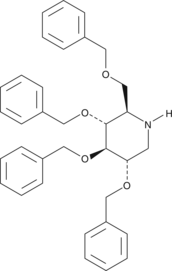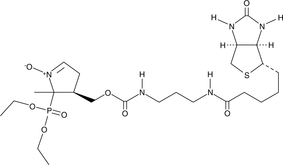Chemicals
Showing 16801–16950 of 41137 results
-
Delsoline is a diterpene alkaloid that has been found in Delphinium and has diverse biological activities.{61115,61116,61117} It inhibits binding of α-bungarotoxin (Item No. 16385) to rat neuronal α7 nicotinic acetylcholine receptors (nAChRs; IC50 = 19 µM).{61115} Delsoline (3 mg/ml) is repellent against adult red flour beetles (T. castaneum) in a filter paper assay.{61116} In vivo, delsoline (75 mg/kg) lowers systolic blood pressure in a rat model of left renal artery ligation-induced hypertension.{61117}
Brand:CaymanSKU:31748 - 1 mgAvailable on backorder
Delsoline is a diterpene alkaloid that has been found in Delphinium and has diverse biological activities.{61115,61116,61117} It inhibits binding of α-bungarotoxin (Item No. 16385) to rat neuronal α7 nicotinic acetylcholine receptors (nAChRs; IC50 = 19 µM).{61115} Delsoline (3 mg/ml) is repellent against adult red flour beetles (T. castaneum) in a filter paper assay.{61116} In vivo, delsoline (75 mg/kg) lowers systolic blood pressure in a rat model of left renal artery ligation-induced hypertension.{61117}
Brand:CaymanSKU:31748 - 10 mgAvailable on backorder
Delsoline is a diterpene alkaloid that has been found in Delphinium and has diverse biological activities.{61115,61116,61117} It inhibits binding of α-bungarotoxin (Item No. 16385) to rat neuronal α7 nicotinic acetylcholine receptors (nAChRs; IC50 = 19 µM).{61115} Delsoline (3 mg/ml) is repellent against adult red flour beetles (T. castaneum) in a filter paper assay.{61116} In vivo, delsoline (75 mg/kg) lowers systolic blood pressure in a rat model of left renal artery ligation-induced hypertension.{61117}
Brand:CaymanSKU:31748 - 5 mgAvailable on backorder
Deltamethrin is a type II pyrethroid insecticide and a modulator of voltage-gated sodium channels (Nav).{36375} It binds to Drosophila para Nav channels in a use-dependent manner following brief depolarizing prepulses and with increasing concentrations of 1 to 5 nM, indicating that it preferentially binds to the channel in the open state.{41828} It slowly activates Nav1.8 channels, delays inactivation by longer than 40 ms, and induces persistent tail currents for channels expressed in X. laevis oocytes.{36375} Deltamethrin decreases proliferation of MCF-7 cells and inhibits androgen receptor transactivation when used at concentrations of 10 and 20 µM or greater, respectively. However, it is not cytotoxic to MCF-7 and CHO cells at concentrations of 25 and 100 µM, respectively, and does not induce transactivation of the estrogen receptor.{41692} Deltamethrin is lethal to mice with an LD50 value of 50 mg/kg and at low sublethal doses of 0.05 and 0.1 mg/kg it induces histopathological changes in the liver, kidney, spleen, and testes, including a loss of spermatozoa and Sertoli cells.{41829}
Brand:CaymanSKU:24172 - 100 mgAvailable on backorder
Deltamethrin is a type II pyrethroid insecticide and a modulator of voltage-gated sodium channels (Nav).{36375} It binds to Drosophila para Nav channels in a use-dependent manner following brief depolarizing prepulses and with increasing concentrations of 1 to 5 nM, indicating that it preferentially binds to the channel in the open state.{41828} It slowly activates Nav1.8 channels, delays inactivation by longer than 40 ms, and induces persistent tail currents for channels expressed in X. laevis oocytes.{36375} Deltamethrin decreases proliferation of MCF-7 cells and inhibits androgen receptor transactivation when used at concentrations of 10 and 20 µM or greater, respectively. However, it is not cytotoxic to MCF-7 and CHO cells at concentrations of 25 and 100 µM, respectively, and does not induce transactivation of the estrogen receptor.{41692} Deltamethrin is lethal to mice with an LD50 value of 50 mg/kg and at low sublethal doses of 0.05 and 0.1 mg/kg it induces histopathological changes in the liver, kidney, spleen, and testes, including a loss of spermatozoa and Sertoli cells.{41829}
Brand:CaymanSKU:24172 - 50 mgAvailable on backorder
KRAS is an oncogene product that acts as a GTPase tethered to cell membranes to assist in various cell signaling pathways. The prenyl-binding protein PDEδ regulates the correct localization and signaling of farnesylated KRAS by facilitating its diffusion to the cytoplasm. Deltarasin is a small molecule that binds to the farnesyl-binding pocket of PDEδ (Kd = 41 nM) in cells thus inhibiting its interaction with KRAS and disrupting RAS signaling.{25383} Treatment of human pancreatic ductal adenocarcinoma cell models with 5 μM deltarasin has been reported to prevent KRAS plasma membrane localization and subsequent solubilization by PDEδ, resulting in reduced proliferation and increased cell death of Panc-Tu-I tumor cells.{25383} Furthermore, in nude mice bearing pancreatic carcinoma xenografts, deltarasin has been shown to reduce tumor growth at a dose of 10 mg/kg.{25383}
Brand:CaymanSKU:9001536 - 1 mgAvailable on backorder
KRAS is an oncogene product that acts as a GTPase tethered to cell membranes to assist in various cell signaling pathways. The prenyl-binding protein PDEδ regulates the correct localization and signaling of farnesylated KRAS by facilitating its diffusion to the cytoplasm. Deltarasin is a small molecule that binds to the farnesyl-binding pocket of PDEδ (Kd = 41 nM) in cells thus inhibiting its interaction with KRAS and disrupting RAS signaling.{25383} Treatment of human pancreatic ductal adenocarcinoma cell models with 5 μM deltarasin has been reported to prevent KRAS plasma membrane localization and subsequent solubilization by PDEδ, resulting in reduced proliferation and increased cell death of Panc-Tu-I tumor cells.{25383} Furthermore, in nude mice bearing pancreatic carcinoma xenografts, deltarasin has been shown to reduce tumor growth at a dose of 10 mg/kg.{25383}
Brand:CaymanSKU:9001536 - 10 mgAvailable on backorder
KRAS is an oncogene product that acts as a GTPase tethered to cell membranes to assist in various cell signaling pathways. The prenyl-binding protein PDEδ regulates the correct localization and signaling of farnesylated KRAS by facilitating its diffusion to the cytoplasm. Deltarasin is a small molecule that binds to the farnesyl-binding pocket of PDEδ (Kd = 41 nM) in cells thus inhibiting its interaction with KRAS and disrupting RAS signaling.{25383} Treatment of human pancreatic ductal adenocarcinoma cell models with 5 μM deltarasin has been reported to prevent KRAS plasma membrane localization and subsequent solubilization by PDEδ, resulting in reduced proliferation and increased cell death of Panc-Tu-I tumor cells.{25383} Furthermore, in nude mice bearing pancreatic carcinoma xenografts, deltarasin has been shown to reduce tumor growth at a dose of 10 mg/kg.{25383}
Brand:CaymanSKU:9001536 - 5 mgAvailable on backorder
Demeclocycline is a broad-spectrum tetracycline antibiotic produced by S. aureofaciens.{40080} It has antimicrobial activity against ~3,200 pathogenic Gram-positive and Gram-negative bacteria in vitro that is 2-fold greater than that of tetracycline (Item No. 14328). The bactericidal action of demeclocycline is comparable to that of chlortetracycline but the duration of action is longer due to its resistance to degradation by acids or alkalis. It is effective against S. pyogenes and K. pneumoniae infections in vivo when administered orally or subcutaneously in mice. Demeclocycline decreases aquaporin 2 (AQP2) water channel gene transcription and protein abundance in mpkCCD murine collecting duct cells in a dose-dependent manner.{40081} It also increases urine volume, decreases urine osmolity, and increases fractional excretion of water in a rat model of hyponatremia. Formulations containing demeclocycline have been used to treat hyponatremia due to syndrome of inappropriate antidiuretic hormone secretion (SIADH) and as endodontic antibiotics to prevent infection following root canal procedures.{40082,40083}
Brand:CaymanSKU:21759 -Out of stock
Demeclocycline is a broad-spectrum tetracycline antibiotic produced by S. aureofaciens.{40080} It has antimicrobial activity against ~3,200 pathogenic Gram-positive and Gram-negative bacteria in vitro that is 2-fold greater than that of tetracycline (Item No. 14328). The bactericidal action of demeclocycline is comparable to that of chlortetracycline but the duration of action is longer due to its resistance to degradation by acids or alkalis. It is effective against S. pyogenes and K. pneumoniae infections in vivo when administered orally or subcutaneously in mice. Demeclocycline decreases aquaporin 2 (AQP2) water channel gene transcription and protein abundance in mpkCCD murine collecting duct cells in a dose-dependent manner.{40081} It also increases urine volume, decreases urine osmolity, and increases fractional excretion of water in a rat model of hyponatremia. Formulations containing demeclocycline have been used to treat hyponatremia due to syndrome of inappropriate antidiuretic hormone secretion (SIADH) and as endodontic antibiotics to prevent infection following root canal procedures.{40082,40083}
Brand:CaymanSKU:21759 -Out of stock
Demethoxycurcumin (DMC) is a natural demethoxy derivative of curcumin. More stable than curcumin in physiological media, DMC suppresses proliferation in cancer cells at 50-100 μM.{19787} It down-regulates the transcriptional coactivator p300, suppressing the Wnt/β-catenin pathway, and inhibits lipopolysaccharide induction of iNOS.{19784}
Brand:CaymanSKU:10961 - 1 mgAvailable on backorder
Demethoxycurcumin (DMC) is a natural demethoxy derivative of curcumin. More stable than curcumin in physiological media, DMC suppresses proliferation in cancer cells at 50-100 μM.{19787} It down-regulates the transcriptional coactivator p300, suppressing the Wnt/β-catenin pathway, and inhibits lipopolysaccharide induction of iNOS.{19784}
Brand:CaymanSKU:10961 - 10 mgAvailable on backorder
Demethoxycurcumin (DMC) is a natural demethoxy derivative of curcumin. More stable than curcumin in physiological media, DMC suppresses proliferation in cancer cells at 50-100 μM.{19787} It down-regulates the transcriptional coactivator p300, suppressing the Wnt/β-catenin pathway, and inhibits lipopolysaccharide induction of iNOS.{19784}
Brand:CaymanSKU:10961 - 25 mgAvailable on backorder
Demethoxycurcumin (DMC) is a natural demethoxy derivative of curcumin. More stable than curcumin in physiological media, DMC suppresses proliferation in cancer cells at 50-100 μM.{19787} It down-regulates the transcriptional coactivator p300, suppressing the Wnt/β-catenin pathway, and inhibits lipopolysaccharide induction of iNOS.{19784}
Brand:CaymanSKU:10961 - 5 mgAvailable on backorder
Demethoxyviridiol is a mycotoxin originally isolated from N. hinnuleum.{47358} It induces lethality in day-old cockerels (LD50 = 4.2 mg/kg). Demethoxyviridiol is also an inhibitor of phosphatidylinositol 3-kinase (PI3K).{31278}
Brand:CaymanSKU:27953 - 1 mgAvailable on backorder
Demethoxyviridiol is a mycotoxin originally isolated from N. hinnuleum.{47358} It induces lethality in day-old cockerels (LD50 = 4.2 mg/kg). Demethoxyviridiol is also an inhibitor of phosphatidylinositol 3-kinase (PI3K).{31278}
Brand:CaymanSKU:27953 - 5 mgAvailable on backorder
Demethylasterriquinone B1 (DMAQ B1) is a natural insulin mimic that activates insulin receptor tyrosine kinase (IRTK; EC50 = 6 µM).{33106,33107,33108,33109} It less potently activates IGF1R and EGFR (EC50s = 100 µM for both). DMAQ B1 induces glucose uptake in adipocytes and skeletal muscle cells without activating proliferation. DMAQ B1 binds GAPDH in vitro.{33105}
Brand:CaymanSKU:21026 -Out of stock
Demethylasterriquinone B1 (DMAQ B1) is a natural insulin mimic that activates insulin receptor tyrosine kinase (IRTK; EC50 = 6 µM).{33106,33107,33108,33109} It less potently activates IGF1R and EGFR (EC50s = 100 µM for both). DMAQ B1 induces glucose uptake in adipocytes and skeletal muscle cells without activating proliferation. DMAQ B1 binds GAPDH in vitro.{33105}
Brand:CaymanSKU:21026 -Out of stock
Demethylwedelolactone (DWL) is a coumestan, originally isolated from E. alba, with diverse biological activities.{40154,40155,40156,40157} It reduces cytotoxicity induced by CCL4 and galactosamine (GaIN; Item No. 22981) in rat hepatocytes in a dose-dependent manner.{40154} DWL inhibits trypsin with an IC50 value of 3.0 μg/ml in vitro.{40155} It is the major constituent in purified butanolic extracts of E. prostrata which inhibit lethal and hemorrhagic activities of C. rhodostoma venom.{40156} DWL also inhibits anchorage-independent cell growth of MDA-MB-231 breast cancer cells and decreases the number of lung metastases in an MDA-MB-231 xenograft model in nude mice.{40157}
Brand:CaymanSKU:11703 - 1 mgAvailable on backorder
Demethylwedelolactone (DWL) is a coumestan, originally isolated from E. alba, with diverse biological activities.{40154,40155,40156,40157} It reduces cytotoxicity induced by CCL4 and galactosamine (GaIN; Item No. 22981) in rat hepatocytes in a dose-dependent manner.{40154} DWL inhibits trypsin with an IC50 value of 3.0 μg/ml in vitro.{40155} It is the major constituent in purified butanolic extracts of E. prostrata which inhibit lethal and hemorrhagic activities of C. rhodostoma venom.{40156} DWL also inhibits anchorage-independent cell growth of MDA-MB-231 breast cancer cells and decreases the number of lung metastases in an MDA-MB-231 xenograft model in nude mice.{40157}
Brand:CaymanSKU:11703 - 10 mgAvailable on backorder
Demethylwedelolactone (DWL) is a coumestan, originally isolated from E. alba, with diverse biological activities.{40154,40155,40156,40157} It reduces cytotoxicity induced by CCL4 and galactosamine (GaIN; Item No. 22981) in rat hepatocytes in a dose-dependent manner.{40154} DWL inhibits trypsin with an IC50 value of 3.0 μg/ml in vitro.{40155} It is the major constituent in purified butanolic extracts of E. prostrata which inhibit lethal and hemorrhagic activities of C. rhodostoma venom.{40156} DWL also inhibits anchorage-independent cell growth of MDA-MB-231 breast cancer cells and decreases the number of lung metastases in an MDA-MB-231 xenograft model in nude mice.{40157}
Brand:CaymanSKU:11703 - 5 mgAvailable on backorder
Demethylwedelolactone (DWL) is a coumestan, originally isolated from E. alba, with diverse biological activities.{40154,40155,40156,40157} It reduces cytotoxicity induced by CCL4 and galactosamine (GaIN; Item No. 22981) in rat hepatocytes in a dose-dependent manner.{40154} DWL inhibits trypsin with an IC50 value of 3.0 μg/ml in vitro.{40155} It is the major constituent in purified butanolic extracts of E. prostrata which inhibit lethal and hemorrhagic activities of C. rhodostoma venom.{40156} DWL also inhibits anchorage-independent cell growth of MDA-MB-231 breast cancer cells and decreases the number of lung metastases in an MDA-MB-231 xenograft model in nude mice.{40157}
Brand:CaymanSKU:11703 - 500 µgAvailable on backorder
Demethylzeylasteral is a nortriterpenoid originally isolated from T. wilfordii that has diverse biological activities, including enzyme inhibitory, anti-angiogenic, antiproliferative, anti-inflammatory, and immunosuppressive properties.{45479,45480,45481,45482} Demethylzeylasteral inhibits the UDP-glucuronosyltransferase (UGT) isoforms UGT1A6 and UGT2B7 (Kis = 0.6 and 17.3 μM, respectively).{45480} It inhibits growth of bovine aortic endothelial cells (BAEs) and U251 human glioma cancer cells in vitro (IC50s = 0.21 and ~6.2 μM, respectively), as well as inhibits tumor growth and neovascularization in vivo in a B16/F10 melanoma mouse allograft model when administered at a dose of 30 mg/kg per day.{45479} Demethylzeylasteral (0.12 mg/kg per day) decreases renal proteinuria, lesions, immune cell infiltration, and protein levels of TNF-α, COX-2, and ICAM-1 in lupus-prone MRL/lpr mice.{45481} Demethylzeylasteral (10 mg/kg per day) also increases survival of recipient rats in a model of kidney transplant.{45482}
Brand:CaymanSKU:28595 - 1 mgAvailable on backorder
Demethylzeylasteral is a nortriterpenoid originally isolated from T. wilfordii that has diverse biological activities, including enzyme inhibitory, anti-angiogenic, antiproliferative, anti-inflammatory, and immunosuppressive properties.{45479,45480,45481,45482} Demethylzeylasteral inhibits the UDP-glucuronosyltransferase (UGT) isoforms UGT1A6 and UGT2B7 (Kis = 0.6 and 17.3 μM, respectively).{45480} It inhibits growth of bovine aortic endothelial cells (BAEs) and U251 human glioma cancer cells in vitro (IC50s = 0.21 and ~6.2 μM, respectively), as well as inhibits tumor growth and neovascularization in vivo in a B16/F10 melanoma mouse allograft model when administered at a dose of 30 mg/kg per day.{45479} Demethylzeylasteral (0.12 mg/kg per day) decreases renal proteinuria, lesions, immune cell infiltration, and protein levels of TNF-α, COX-2, and ICAM-1 in lupus-prone MRL/lpr mice.{45481} Demethylzeylasteral (10 mg/kg per day) also increases survival of recipient rats in a model of kidney transplant.{45482}
Brand:CaymanSKU:28595 - 10 mgAvailable on backorder
Demethylzeylasteral is a nortriterpenoid originally isolated from T. wilfordii that has diverse biological activities, including enzyme inhibitory, anti-angiogenic, antiproliferative, anti-inflammatory, and immunosuppressive properties.{45479,45480,45481,45482} Demethylzeylasteral inhibits the UDP-glucuronosyltransferase (UGT) isoforms UGT1A6 and UGT2B7 (Kis = 0.6 and 17.3 μM, respectively).{45480} It inhibits growth of bovine aortic endothelial cells (BAEs) and U251 human glioma cancer cells in vitro (IC50s = 0.21 and ~6.2 μM, respectively), as well as inhibits tumor growth and neovascularization in vivo in a B16/F10 melanoma mouse allograft model when administered at a dose of 30 mg/kg per day.{45479} Demethylzeylasteral (0.12 mg/kg per day) decreases renal proteinuria, lesions, immune cell infiltration, and protein levels of TNF-α, COX-2, and ICAM-1 in lupus-prone MRL/lpr mice.{45481} Demethylzeylasteral (10 mg/kg per day) also increases survival of recipient rats in a model of kidney transplant.{45482}
Brand:CaymanSKU:28595 - 5 mgAvailable on backorder
Denatonium (benzoate salt) (Item No. 26350) is an analytical reference standard categorized as a bittering agent.{42560} Formulations containing denatonium have been used as bittering agents to reduce ingestion of toxic substances by children. This product is intended for research and forensic applications.
Brand:CaymanSKU:26350 - 5 mgAvailable on backorder
Dendrobine is a sesquiterpenoid that has been found in D. nobile and has anticancer activity.{46864,46865} It decreases viability of A549 cells when used at concentrations ranging from 2.5 to 15 µg/ml.{46865} It induces apoptosis in A549 cells when used at concentrations ranging from 1 to 10 µg/ml, as well as increases JNK phosphorylation and sensitizes A549 cells to cisplatin (Item No. 13119) at 10 µg/ml. Dendrobine (50 mg/kg per day) reduces tumor growth in an A549 mouse xenograft model with an additive effect when used in combination with cisplatin.
Brand:CaymanSKU:26067 - 10 mgAvailable on backorder
Dendrobine is a sesquiterpenoid that has been found in D. nobile and has anticancer activity.{46864,46865} It decreases viability of A549 cells when used at concentrations ranging from 2.5 to 15 µg/ml.{46865} It induces apoptosis in A549 cells when used at concentrations ranging from 1 to 10 µg/ml, as well as increases JNK phosphorylation and sensitizes A549 cells to cisplatin (Item No. 13119) at 10 µg/ml. Dendrobine (50 mg/kg per day) reduces tumor growth in an A549 mouse xenograft model with an additive effect when used in combination with cisplatin.
Brand:CaymanSKU:26067 - 25 mgAvailable on backorder
Dendrobine is a sesquiterpenoid that has been found in D. nobile and has anticancer activity.{46864,46865} It decreases viability of A549 cells when used at concentrations ranging from 2.5 to 15 µg/ml.{46865} It induces apoptosis in A549 cells when used at concentrations ranging from 1 to 10 µg/ml, as well as increases JNK phosphorylation and sensitizes A549 cells to cisplatin (Item No. 13119) at 10 µg/ml. Dendrobine (50 mg/kg per day) reduces tumor growth in an A549 mouse xenograft model with an additive effect when used in combination with cisplatin.
Brand:CaymanSKU:26067 - 5 mgAvailable on backorder
Dendrobine is a sesquiterpenoid that has been found in D. nobile and has anticancer activity.{46864,46865} It decreases viability of A549 cells when used at concentrations ranging from 2.5 to 15 µg/ml.{46865} It induces apoptosis in A549 cells when used at concentrations ranging from 1 to 10 µg/ml, as well as increases JNK phosphorylation and sensitizes A549 cells to cisplatin (Item No. 13119) at 10 µg/ml. Dendrobine (50 mg/kg per day) reduces tumor growth in an A549 mouse xenograft model with an additive effect when used in combination with cisplatin.
Brand:CaymanSKU:26067 - 50 mgAvailable on backorder
Denudatine is an alkaloid that has been found in A. jinyangense and has antiarrhythmic activity.{58134} In vivo, denudatine (50 and 100 mg/kg) prevents aconitine-induced arrhythmias in rats and increases survival in a rat model of calcium chloride-induced arrhythmias.
Brand:CaymanSKU:30904 - 1 mgAvailable on backorder
Denudatine is an alkaloid that has been found in A. jinyangense and has antiarrhythmic activity.{58134} In vivo, denudatine (50 and 100 mg/kg) prevents aconitine-induced arrhythmias in rats and increases survival in a rat model of calcium chloride-induced arrhythmias.
Brand:CaymanSKU:30904 - 10 mgAvailable on backorder
Denudatine is an alkaloid that has been found in A. jinyangense and has antiarrhythmic activity.{58134} In vivo, denudatine (50 and 100 mg/kg) prevents aconitine-induced arrhythmias in rats and increases survival in a rat model of calcium chloride-induced arrhythmias.
Brand:CaymanSKU:30904 - 25 mgAvailable on backorder
Denudatine is an alkaloid that has been found in A. jinyangense and has antiarrhythmic activity.{58134} In vivo, denudatine (50 and 100 mg/kg) prevents aconitine-induced arrhythmias in rats and increases survival in a rat model of calcium chloride-induced arrhythmias.
Brand:CaymanSKU:30904 - 5 mgAvailable on backorder
Deoxy donepezil is a potential impurity found in bulk preparations of the acetylcholinesterase inhibitor donepezil (Item No. 13245).{46789} It is produced as a by-product during donepezil synthesis.{46790}
Brand:CaymanSKU:30045 - 1 mgAvailable on backorder
Deoxy donepezil is a potential impurity found in bulk preparations of the acetylcholinesterase inhibitor donepezil (Item No. 13245).{46789} It is produced as a by-product during donepezil synthesis.{46790}
Brand:CaymanSKU:30045 - 10 mgAvailable on backorder
Deoxy donepezil is a potential impurity found in bulk preparations of the acetylcholinesterase inhibitor donepezil (Item No. 13245).{46789} It is produced as a by-product during donepezil synthesis.{46790}
Brand:CaymanSKU:30045 - 5 mgAvailable on backorder
Deoxy donepezil is a potential impurity found in bulk preparations of the acetylcholinesterase inhibitor donepezil (Item No. 13245).{46789} It is produced as a by-product during donepezil synthesis.{46790}
Brand:CaymanSKU:30045 - 500 µgAvailable on backorder
Deoxyarbutin is a tyrosinase inhibitor (IC50 = 17.5 μM for mushroom tyrosinase).{54107} It reduces melanin content in isolated dark human melanocytes when used at a concentration of 1.56 μM.{54108} Topical administration of deoxyarbutin (5%) induces skin lightening in human skin mouse xenograft models. Deoxyarbutin also inhibits proliferation of B16/F10 murine melanoma cells (EC50 = 39.56 μM).{54109} It induces apoptosis and halts the cell cycle at the S phase in B16/F10 cells when used at a concentration of 50 μM. Deoxyarbutin (50 mg/kg) reduces tumor growth in a B16/F10 murine melanoma model.
Brand:CaymanSKU:21077 -Out of stock
Deoxyarbutin is a tyrosinase inhibitor (IC50 = 17.5 μM for mushroom tyrosinase).{54107} It reduces melanin content in isolated dark human melanocytes when used at a concentration of 1.56 μM.{54108} Topical administration of deoxyarbutin (5%) induces skin lightening in human skin mouse xenograft models. Deoxyarbutin also inhibits proliferation of B16/F10 murine melanoma cells (EC50 = 39.56 μM).{54109} It induces apoptosis and halts the cell cycle at the S phase in B16/F10 cells when used at a concentration of 50 μM. Deoxyarbutin (50 mg/kg) reduces tumor growth in a B16/F10 murine melanoma model.
Brand:CaymanSKU:21077 -Out of stock
Deoxyarbutin is a tyrosinase inhibitor (IC50 = 17.5 μM for mushroom tyrosinase).{54107} It reduces melanin content in isolated dark human melanocytes when used at a concentration of 1.56 μM.{54108} Topical administration of deoxyarbutin (5%) induces skin lightening in human skin mouse xenograft models. Deoxyarbutin also inhibits proliferation of B16/F10 murine melanoma cells (EC50 = 39.56 μM).{54109} It induces apoptosis and halts the cell cycle at the S phase in B16/F10 cells when used at a concentration of 50 μM. Deoxyarbutin (50 mg/kg) reduces tumor growth in a B16/F10 murine melanoma model.
Brand:CaymanSKU:21077 -Out of stock
Deoxyarbutin is a tyrosinase inhibitor (IC50 = 17.5 μM for mushroom tyrosinase).{54107} It reduces melanin content in isolated dark human melanocytes when used at a concentration of 1.56 μM.{54108} Topical administration of deoxyarbutin (5%) induces skin lightening in human skin mouse xenograft models. Deoxyarbutin also inhibits proliferation of B16/F10 murine melanoma cells (EC50 = 39.56 μM).{54109} It induces apoptosis and halts the cell cycle at the S phase in B16/F10 cells when used at a concentration of 50 μM. Deoxyarbutin (50 mg/kg) reduces tumor growth in a B16/F10 murine melanoma model.
Brand:CaymanSKU:21077 -Out of stock
Deoxybrevianamide E is an alkaloid fungal metabolite that has been found in Aspergillus.{47166} It is a precursor in the biosynthesis of notoamides.
Brand:CaymanSKU:26662 - 1 mgAvailable on backorder
Deoxybrevianamide E is an alkaloid fungal metabolite that has been found in Aspergillus.{47166} It is a precursor in the biosynthesis of notoamides.
Brand:CaymanSKU:26662 - 5 mgAvailable on backorder
Deoxycholic acid (DCA) is a secondary bile acid that is formed via microbial transformation of cholic acid (Item No. 20250) in the colon.{54006} It can be conjugated to glycine or taurine (Item No. 27031) to produce glycodeoxycholic acid (GDCA; Item No. 20274) or taurodeoxycholic acid (TDCA; Item No. 15935), respectively, in hepatocytes.{54006,33902,52692} DCA (0.2% v/v) inhibits spore germination induced by taurocholic acid (TCA; Item No. 16215) in seven C. difficile strains, as well as inhibits growth and decreases the cytotoxicity of C. difficile culture supernatants to Vero cells when used at a concentration of 0.02% v/v.{54006} It inhibits ionizing radiation-induced p53-dependent transcription in a reporter assay using HCT116 cells when used at a concentration of 200 µM.{52693} Fecal and intestinal tissue levels of DCA are increased in a rat model of high-fat diet-induced obesity compared with rats fed a normal diet.{54007} Increased serum DCA levels have been found in patients with colorectal cancer.{52694}
Brand:CaymanSKU:20756 -Available on backorder
Deoxycholic acid (DCA) is a secondary bile acid that is formed via microbial transformation of cholic acid (Item No. 20250) in the colon.{54006} It can be conjugated to glycine or taurine (Item No. 27031) to produce glycodeoxycholic acid (GDCA; Item No. 20274) or taurodeoxycholic acid (TDCA; Item No. 15935), respectively, in hepatocytes.{54006,33902,52692} DCA (0.2% v/v) inhibits spore germination induced by taurocholic acid (TCA; Item No. 16215) in seven C. difficile strains, as well as inhibits growth and decreases the cytotoxicity of C. difficile culture supernatants to Vero cells when used at a concentration of 0.02% v/v.{54006} It inhibits ionizing radiation-induced p53-dependent transcription in a reporter assay using HCT116 cells when used at a concentration of 200 µM.{52693} Fecal and intestinal tissue levels of DCA are increased in a rat model of high-fat diet-induced obesity compared with rats fed a normal diet.{54007} Increased serum DCA levels have been found in patients with colorectal cancer.{52694}
Brand:CaymanSKU:20756 -Available on backorder
Deoxycholic acid (DCA) is a secondary bile acid that is formed via microbial transformation of cholic acid (Item No. 20250) in the colon.{54006} It can be conjugated to glycine or taurine (Item No. 27031) to produce glycodeoxycholic acid (GDCA; Item No. 20274) or taurodeoxycholic acid (TDCA; Item No. 15935), respectively, in hepatocytes.{54006,33902,52692} DCA (0.2% v/v) inhibits spore germination induced by taurocholic acid (TCA; Item No. 16215) in seven C. difficile strains, as well as inhibits growth and decreases the cytotoxicity of C. difficile culture supernatants to Vero cells when used at a concentration of 0.02% v/v.{54006} It inhibits ionizing radiation-induced p53-dependent transcription in a reporter assay using HCT116 cells when used at a concentration of 200 µM.{52693} Fecal and intestinal tissue levels of DCA are increased in a rat model of high-fat diet-induced obesity compared with rats fed a normal diet.{54007} Increased serum DCA levels have been found in patients with colorectal cancer.{52694}
Brand:CaymanSKU:20756 -Available on backorder
Deoxycholic acid (DCA) is a secondary bile acid that is formed via microbial transformation of cholic acid (Item No. 20250) in the colon.{54006} It can be conjugated to glycine or taurine (Item No. 27031) to produce glycodeoxycholic acid (GDCA; Item No. 20274) or taurodeoxycholic acid (TDCA; Item No. 15935), respectively, in hepatocytes.{54006,33902,52692} DCA (0.2% v/v) inhibits spore germination induced by taurocholic acid (TCA; Item No. 16215) in seven C. difficile strains, as well as inhibits growth and decreases the cytotoxicity of C. difficile culture supernatants to Vero cells when used at a concentration of 0.02% v/v.{54006} It inhibits ionizing radiation-induced p53-dependent transcription in a reporter assay using HCT116 cells when used at a concentration of 200 µM.{52693} Fecal and intestinal tissue levels of DCA are increased in a rat model of high-fat diet-induced obesity compared with rats fed a normal diet.{54007} Increased serum DCA levels have been found in patients with colorectal cancer.{52694}
Brand:CaymanSKU:20756 -Available on backorder
Deoxycholic acid (DCA) is a secondary bile acid that is formed via microbial transformation of cholic acid (Item No. 20250) in the colon.{54006} It can be conjugated to glycine or taurine (Item No. 27031) to produce glycodeoxycholic acid (GDCA; Item No. 20274) or taurodeoxycholic acid (TDCA; Item No. 15935), respectively, in hepatocytes.{54006,33902,52692} DCA (0.2% v/v) inhibits spore germination induced by taurocholic acid (TCA; Item No. 16215) in seven C. difficile strains, as well as inhibits growth and decreases the cytotoxicity of C. difficile culture supernatants to Vero cells when used at a concentration of 0.02% v/v.{54006} It inhibits ionizing radiation-induced p53-dependent transcription in a reporter assay using HCT116 cells when used at a concentration of 200 µM.{52693} Fecal and intestinal tissue levels of DCA are increased in a rat model of high-fat diet-induced obesity compared with rats fed a normal diet.{54007} Increased serum DCA levels have been found in patients with colorectal cancer.{52694}
Brand:CaymanSKU:-Available on backorder
Deoxycholic acid (DCA) is a secondary bile acid that is formed via microbial transformation of cholic acid (Item No. 20250) in the colon.{54006} It can be conjugated to glycine or taurine (Item No. 27031) to produce glycodeoxycholic acid (GDCA; Item No. 20274) or taurodeoxycholic acid (TDCA; Item No. 15935), respectively, in hepatocytes.{54006,33902,52692} DCA (0.2% v/v) inhibits spore germination induced by taurocholic acid (TCA; Item No. 16215) in seven C. difficile strains, as well as inhibits growth and decreases the cytotoxicity of C. difficile culture supernatants to Vero cells when used at a concentration of 0.02% v/v.{54006} It inhibits ionizing radiation-induced p53-dependent transcription in a reporter assay using HCT116 cells when used at a concentration of 200 µM.{52693} Fecal and intestinal tissue levels of DCA are increased in a rat model of high-fat diet-induced obesity compared with rats fed a normal diet.{54007} Increased serum DCA levels have been found in patients with colorectal cancer.{52694}
Brand:CaymanSKU:-Available on backorder
Deoxycholic acid (DCA) is a secondary bile acid that is formed via microbial transformation of cholic acid (Item No. 20250) in the colon.{54006} It can be conjugated to glycine or taurine (Item No. 27031) to produce glycodeoxycholic acid (GDCA; Item No. 20274) or taurodeoxycholic acid (TDCA; Item No. 15935), respectively, in hepatocytes.{54006,33902,52692} DCA (0.2% v/v) inhibits spore germination induced by taurocholic acid (TCA; Item No. 16215) in seven C. difficile strains, as well as inhibits growth and decreases the cytotoxicity of C. difficile culture supernatants to Vero cells when used at a concentration of 0.02% v/v.{54006} It inhibits ionizing radiation-induced p53-dependent transcription in a reporter assay using HCT116 cells when used at a concentration of 200 µM.{52693} Fecal and intestinal tissue levels of DCA are increased in a rat model of high-fat diet-induced obesity compared with rats fed a normal diet.{54007} Increased serum DCA levels have been found in patients with colorectal cancer.{52694}
Brand:CaymanSKU:-Available on backorder
Deoxycholic acid (DCA) is a secondary bile acid that is formed via microbial transformation of cholic acid (Item No. 20250) in the colon.{54006} It can be conjugated to glycine or taurine (Item No. 27031) to produce glycodeoxycholic acid (GDCA; Item No. 20274) or taurodeoxycholic acid (TDCA; Item No. 15935), respectively, in hepatocytes.{54006,33902,52692} DCA (0.2% v/v) inhibits spore germination induced by taurocholic acid (TCA; Item No. 16215) in seven C. difficile strains, as well as inhibits growth and decreases the cytotoxicity of C. difficile culture supernatants to Vero cells when used at a concentration of 0.02% v/v.{54006} It inhibits ionizing radiation-induced p53-dependent transcription in a reporter assay using HCT116 cells when used at a concentration of 200 µM.{52693} Fecal and intestinal tissue levels of DCA are increased in a rat model of high-fat diet-induced obesity compared with rats fed a normal diet.{54007} Increased serum DCA levels have been found in patients with colorectal cancer.{52694}
Brand:CaymanSKU:-Available on backorder
Deoxycholic acid (DCA) is a secondary bile acid that is formed via microbial transformation of cholic acid (Item No. 20250) in the colon.{54006} It can be conjugated to glycine or taurine (Item No. 27031) to produce glycodeoxycholic acid (GDCA; Item No. 20274) or taurodeoxycholic acid (TDCA; Item No. 15935), respectively, in hepatocytes.{54006,33902,52692} DCA (0.2% v/v) inhibits spore germination induced by taurocholic acid (TCA; Item No. 16215) in seven C. difficile strains, as well as inhibits growth and decreases the cytotoxicity of C. difficile culture supernatants to Vero cells when used at a concentration of 0.02% v/v.{54006} It inhibits ionizing radiation-induced p53-dependent transcription in a reporter assay using HCT116 cells when used at a concentration of 200 µM.{52693} Fecal and intestinal tissue levels of DCA are increased in a rat model of high-fat diet-induced obesity compared with rats fed a normal diet.{54007} Increased serum DCA levels have been found in patients with colorectal cancer.{52694} Deoxycholic acid MaxSpec® standard is a quantitative grade standard of deoxycholic acid (Item No. 20756) that has been prepared specifically for mass spectrometry and related applications where quantitative reproducibility is required. The solution has been prepared gravimetrically and is supplied in a deactivated glass ampule sealed under argon. The concentration was verified by comparison to an independently prepared calibration standard. This deoxycholic acid MaxSpec® standard is guaranteed to meet identity, purity, stability, and concentration specifications and is provided with a batch-specific certificate of analysis. Ongoing stability testing is performed to ensure the concentration remains accurate throughout the shelf life of the product. Note: The amount of solution added to the vial is in excess of the listed amount. Therefore, it is necessary to accurately measure volumes for preparation of calibration standards. Follow recommended storage and handling conditions to maintain product quality.
Brand:CaymanSKU:31349 - 100 µgAvailable on backorder
Deoxycholic acid-d4 (DCA-d4) is intended for use as an internal standard for the quantification of DCA (Item Nos. 20756 | 18231) by GC- or LC-MS. DCA is a secondary bile acid that is formed via microbial transformation of cholic acid (Item No. 20250) in the colon.{54006} It can be conjugated to glycine or taurine (Item No. 27031) to produce glycodeoxycholic acid (GDCA; Item No. 20274) or taurodeoxycholic acid (TDCA; Item No. 15935), respectively, in hepatocytes.{54006,33902,52692} DCA (0.2% v/v) inhibits spore germination induced by taurocholic acid (TCA; Item No. 16215) in seven C. difficile strains, as well as inhibits growth and decreases the cytotoxicity of C. difficile culture supernatants to Vero cells when used at a concentration of 0.02% v/v.{54006} It inhibits ionizing radiation-induced p53-dependent transcription in a reporter assay using HCT116 cells when used at a concentration of 200 µM.{52693} Fecal and intestinal tissue levels of DCA are increased in a rat model of high-fat diet-induced obesity compared with rats fed a normal diet.{54007} Increased serum DCA levels have been found in patients with colorectal cancer.{52694}
Brand:CaymanSKU:20851 -Out of stock
Deoxycholic acid-d4 (DCA-d4) is intended for use as an internal standard for the quantification of DCA (Item Nos. 20756 | 18231) by GC- or LC-MS. DCA is a secondary bile acid that is formed via microbial transformation of cholic acid (Item No. 20250) in the colon.{54006} It can be conjugated to glycine or taurine (Item No. 27031) to produce glycodeoxycholic acid (GDCA; Item No. 20274) or taurodeoxycholic acid (TDCA; Item No. 15935), respectively, in hepatocytes.{54006,33902,52692} DCA (0.2% v/v) inhibits spore germination induced by taurocholic acid (TCA; Item No. 16215) in seven C. difficile strains, as well as inhibits growth and decreases the cytotoxicity of C. difficile culture supernatants to Vero cells when used at a concentration of 0.02% v/v.{54006} It inhibits ionizing radiation-induced p53-dependent transcription in a reporter assay using HCT116 cells when used at a concentration of 200 µM.{52693} Fecal and intestinal tissue levels of DCA are increased in a rat model of high-fat diet-induced obesity compared with rats fed a normal diet.{54007} Increased serum DCA levels have been found in patients with colorectal cancer.{52694}
Brand:CaymanSKU:20851 -Out of stock
Deoxycholic acid-d4 (DCA-d4) is intended for use as an internal standard for the quantification of DCA (Item Nos. 20756 | 18231) by GC- or LC-MS. DCA is a secondary bile acid that is formed via microbial transformation of cholic acid (Item No. 20250) in the colon.{54006} It can be conjugated to glycine or taurine (Item No. 27031) to produce glycodeoxycholic acid (GDCA; Item No. 20274) or taurodeoxycholic acid (TDCA; Item No. 15935), respectively, in hepatocytes.{54006,33902,52692} DCA (0.2% v/v) inhibits spore germination induced by taurocholic acid (TCA; Item No. 16215) in seven C. difficile strains, as well as inhibits growth and decreases the cytotoxicity of C. difficile culture supernatants to Vero cells when used at a concentration of 0.02% v/v.{54006} It inhibits ionizing radiation-induced p53-dependent transcription in a reporter assay using HCT116 cells when used at a concentration of 200 µM.{52693} Fecal and intestinal tissue levels of DCA are increased in a rat model of high-fat diet-induced obesity compared with rats fed a normal diet.{54007} Increased serum DCA levels have been found in patients with colorectal cancer.{52694}
Brand:CaymanSKU:20851 -Out of stock
Deoxycholic acid-d4 (DCA-d4) is intended for use as an internal standard for the quantification of DCA (Item Nos. 20756 | 18231) by GC- or LC-MS. DCA is a secondary bile acid that is formed via microbial transformation of cholic acid (Item No. 20250) in the colon.{54006} It can be conjugated to glycine or taurine (Item No. 27031) to produce glycodeoxycholic acid (GDCA; Item No. 20274) or taurodeoxycholic acid (TDCA; Item No. 15935), respectively, in hepatocytes.{54006,33902,52692} DCA (0.2% v/v) inhibits spore germination induced by taurocholic acid (TCA; Item No. 16215) in seven C. difficile strains, as well as inhibits growth and decreases the cytotoxicity of C. difficile culture supernatants to Vero cells when used at a concentration of 0.02% v/v.{54006} It inhibits ionizing radiation-induced p53-dependent transcription in a reporter assay using HCT116 cells when used at a concentration of 200 µM.{52693} Fecal and intestinal tissue levels of DCA are increased in a rat model of high-fat diet-induced obesity compared with rats fed a normal diet.{54007} Increased serum DCA levels have been found in patients with colorectal cancer.{52694} DCA-d4 MaxSpec® standard is a quantitative grade standard of DCA-d4 (Item No. 20851) that has been prepared specifically for mass spectrometry and related applications where quantitative reproducibility is required. The solution has been prepared gravimetrically and is supplied in a deactivated glass ampule sealed under argon. The concentration was verified by comparison to an independently prepared calibration standard. This DCA-d4 MaxSpec® standard is guaranteed to meet identity, purity, stability, and concentration specifications and is provided with a batch-specific certificate of analysis. Ongoing stability testing is performed to ensure the concentration remains accurate throughout the shelf life of the product. Note: The amount of solution added to the vial is in excess of the listed amount. Therefore, it is necessary to accurately measure volumes for preparation of calibration standards. Follow recommended storage and handling conditions to maintain product quality.
Brand:CaymanSKU:31350 - 100 µgAvailable on backorder
Deoxycorticosterone acetate (DOCA) is a corticosteroid.{54468} It is an acetylated form of deoxycorticosterone (11-deoxy corticosterone; Item No. 22916). DOCA, in combination with saline via the drinking water, has commonly been used in rodents as a model of salt-sensitive hypertension, characterized by increases in sympathetic nervous system activity, imbalances in the renin-angiotensin system (RAS), and cardiac remodeling.{54469,54470}
Brand:CaymanSKU:30856 - 1 gAvailable on backorder
Deoxycorticosterone acetate (DOCA) is a corticosteroid.{54468} It is an acetylated form of deoxycorticosterone (11-deoxy corticosterone; Item No. 22916). DOCA, in combination with saline via the drinking water, has commonly been used in rodents as a model of salt-sensitive hypertension, characterized by increases in sympathetic nervous system activity, imbalances in the renin-angiotensin system (RAS), and cardiac remodeling.{54469,54470}
Brand:CaymanSKU:30856 - 10 gAvailable on backorder
Deoxycorticosterone acetate (DOCA) is a corticosteroid.{54468} It is an acetylated form of deoxycorticosterone (11-deoxy corticosterone; Item No. 22916). DOCA, in combination with saline via the drinking water, has commonly been used in rodents as a model of salt-sensitive hypertension, characterized by increases in sympathetic nervous system activity, imbalances in the renin-angiotensin system (RAS), and cardiac remodeling.{54469,54470}
Brand:CaymanSKU:30856 - 25 gAvailable on backorder
Deoxycorticosterone acetate (DOCA) is a corticosteroid.{54468} It is an acetylated form of deoxycorticosterone (11-deoxy corticosterone; Item No. 22916). DOCA, in combination with saline via the drinking water, has commonly been used in rodents as a model of salt-sensitive hypertension, characterized by increases in sympathetic nervous system activity, imbalances in the renin-angiotensin system (RAS), and cardiac remodeling.{54469,54470}
Brand:CaymanSKU:30856 - 5 gAvailable on backorder
Deoxyenterocin is a bacterial metabolite originally isolated from Streptomyces that has diverse biological activities, including antibiotic, antiviral, and antioxidant properties.{36890} It inhibits the growth of S. lutea, S. aureus, K. pneumoniae, and V. percolans in vitro when used at a concentration of 500 μg/ml. Deoxyenterocin (50 μg/ml) inhibits the cytopathic effect of influenza A H1N1 virus by 60.6% in vitro.{36891} It also prevents hydrogen peroxide-induced decreases in glutathione (GSH) levels and in the mitochondrial membrane potential in mouse primary cortical neuronal cultures when used at a concentration of 1 μM.{36892}
Brand:CaymanSKU:25764 - 1 mgAvailable on backorder
Deoxyenterocin is a bacterial metabolite originally isolated from Streptomyces that has diverse biological activities, including antibiotic, antiviral, and antioxidant properties.{36890} It inhibits the growth of S. lutea, S. aureus, K. pneumoniae, and V. percolans in vitro when used at a concentration of 500 μg/ml. Deoxyenterocin (50 μg/ml) inhibits the cytopathic effect of influenza A H1N1 virus by 60.6% in vitro.{36891} It also prevents hydrogen peroxide-induced decreases in glutathione (GSH) levels and in the mitochondrial membrane potential in mouse primary cortical neuronal cultures when used at a concentration of 1 μM.{36892}
Brand:CaymanSKU:25764 - 5 mgAvailable on backorder
Deoxyfusapyrone is an α-pyrone fungal metabolite originally isolated from F. semitectum and has antifungal activity.{49155} It is active against C. neoformans, A. fumigatus, A. niger, and A. flavus human mycoses (MICs = 1.56-6.25 μg/ml). Deoxyfusapyrone is also active against a variety of filamentous fungi, but not yeast or the bacterium B. megaterium, in a disc assay.
Brand:CaymanSKU:27963 - 1 mgAvailable on backorder
Deoxyfusapyrone is an α-pyrone fungal metabolite originally isolated from F. semitectum and has antifungal activity.{49155} It is active against C. neoformans, A. fumigatus, A. niger, and A. flavus human mycoses (MICs = 1.56-6.25 μg/ml). Deoxyfusapyrone is also active against a variety of filamentous fungi, but not yeast or the bacterium B. megaterium, in a disc assay.
Brand:CaymanSKU:27963 - 5 mgAvailable on backorder
Deoxygerfelin is a phenolic antioxidant that has been found in A. versicolor.{48877} It scavenges free radicals in a Trolox equivalent activity concentration (TEAC) assay.
Brand:CaymanSKU:29931 - 1 mgAvailable on backorder
Deoxygerfelin is a phenolic antioxidant that has been found in A. versicolor.{48877} It scavenges free radicals in a Trolox equivalent activity concentration (TEAC) assay.
Brand:CaymanSKU:29931 - 5 mgAvailable on backorder
Deoxynojirimycin (dNM) tetrabenzyl ether is an intermediate for the synthesis of glucosylceramide synthase inhibitors such as 1-dNM, a glucose analog that potently inhibits α-glucosidase I and II.{16256}
Brand:CaymanSKU:10011914 - 1 mgAvailable on backorder
Deoxynojirimycin (dNM) tetrabenzyl ether is an intermediate for the synthesis of glucosylceramide synthase inhibitors such as 1-dNM, a glucose analog that potently inhibits α-glucosidase I and II.{16256}
Brand:CaymanSKU:10011914 - 10 mgAvailable on backorder
Deoxynojirimycin (dNM) tetrabenzyl ether is an intermediate for the synthesis of glucosylceramide synthase inhibitors such as 1-dNM, a glucose analog that potently inhibits α-glucosidase I and II.{16256}
Brand:CaymanSKU:10011914 - 5 mgAvailable on backorder
Deoxynojirimycin (dNM) tetrabenzyl ether is an intermediate for the synthesis of glucosylceramide synthase inhibitors such as 1-dNM, a glucose analog that potently inhibits α-glucosidase I and II.{16256}
Brand:CaymanSKU:10011914 - 50 mgAvailable on backorder
Deoxyviolacein is a bacterial metabolite and byproduct in the biosynthesis of the bisindole alkaloid violacein (Item No. 27959) that has anticancer, antibacterial, and antifungal properties.{35176,35174} It inhibits proliferation of hepatocellular carcinoma cells when used at concentrations ranging from 0.1 to 1 µM.{35174} Deoxyviolacein (125 µg/ml) has antibacterial activity against Gram-positive bacteria, including S. aureus, B. subtilis, and B. megaterium.{35176} It also has antifungal activity against R. solani when used at a concentration of 2 mg/ml.
Brand:CaymanSKU:23477 - 2.5 mgAvailable on backorder
Deoxyviolacein is a bacterial metabolite and byproduct in the biosynthesis of the bisindole alkaloid violacein (Item No. 27959) that has anticancer, antibacterial, and antifungal properties.{35176,35174} It inhibits proliferation of hepatocellular carcinoma cells when used at concentrations ranging from 0.1 to 1 µM.{35174} Deoxyviolacein (125 µg/ml) has antibacterial activity against Gram-positive bacteria, including S. aureus, B. subtilis, and B. megaterium.{35176} It also has antifungal activity against R. solani when used at a concentration of 2 mg/ml.
Brand:CaymanSKU:23477 - 500 µgAvailable on backorder
DEPMPO is a phosphorylated derivative of the widely used DMPO spin trap. It has been reported to produce spin adducts with increased stability particularly for the adduct of superoxide.{17433,17434,17435} DEPMPO displays a detectable spin adduct signal at a concentration as low as 1 mM, as compared to 5 mM for DMPO (Item No. 10006436).{17435} A significant advantage of using DEPMPO in trapping superoxide radical is that the decomposition of DEPMPO/O2•- does not produce the OH• adduct, which can be a drawback when using DMPO.{17434,17435}
Brand:CaymanSKU:10006435 - 250 mgAvailable on backorder
DEPMPO is a phosphorylated derivative of the widely used DMPO spin trap. It has been reported to produce spin adducts with increased stability particularly for the adduct of superoxide.{17433,17434,17435} DEPMPO displays a detectable spin adduct signal at a concentration as low as 1 mM, as compared to 5 mM for DMPO (Item No. 10006436).{17435} A significant advantage of using DEPMPO in trapping superoxide radical is that the decomposition of DEPMPO/O2•- does not produce the OH• adduct, which can be a drawback when using DMPO.{17434,17435}
Brand:CaymanSKU:10006435 - 50 mgAvailable on backorder
DEPMPO is a phosphorylated derivative of the widely used DMPO spin trap. It has been reported to produce spin adducts with increased stability particularly for the adduct of superoxide.{17433,17434,17435} DEPMPO displays a detectable spin adduct signal at a concentration as low as 1 mM, as compared to 5 mM for DMPO (Item No. 10006436).{17435} A significant advantage of using DEPMPO in trapping superoxide radical is that the decomposition of DEPMPO/O2•- does not produce the OH• adduct, which can be a drawback when using DMPO.{17434,17435}
Brand:CaymanSKU:10006435 - 500 mgAvailable on backorder
DEPMPO is a nitrone that is used to spin trap reactive O-, N-, S-, and C-centered radicals and allow their characterization when used in association with electron spin resonance. It is noted for the stability of adducts formed.{17433} DEPMPO can be used in vitro or in vivo, as it crosses lipid bilayer membranes and is a good trapping agent in biological systems.{17434,17435} DEPMPO-biotin is a biotinylated form of DEPMPO which retains the outstanding persistency of its adducts.{17436} The biotin moiety offers an effective means for monitoring biodistribution in cells, tissues, and organs when used with an avidin-conjugated reporter. Importantly, DEPMPO-biotin binds free radicals, such as S-nitroso groups, on proteins, producing adducts that can be analyzed via the biotin tag. This direct labeling of S-nitrosothiols (SNO) thus serves as an effective alternative to the more cumbersome biotin-switch method for monitoring SNO formation.
Brand:CaymanSKU:-DEPMPO is a nitrone that is used to spin trap reactive O-, N-, S-, and C-centered radicals and allow their characterization when used in association with electron spin resonance. It is noted for the stability of adducts formed.{17433} DEPMPO can be used in vitro or in vivo, as it crosses lipid bilayer membranes and is a good trapping agent in biological systems.{17434,17435} DEPMPO-biotin is a biotinylated form of DEPMPO which retains the outstanding persistency of its adducts.{17436} The biotin moiety offers an effective means for monitoring biodistribution in cells, tissues, and organs when used with an avidin-conjugated reporter. Importantly, DEPMPO-biotin binds free radicals, such as S-nitroso groups, on proteins, producing adducts that can be analyzed via the biotin tag. This direct labeling of S-nitrosothiols (SNO) thus serves as an effective alternative to the more cumbersome biotin-switch method for monitoring SNO formation.
Brand:CaymanSKU:-DEPMPO is a nitrone that is used to spin trap reactive O-, N-, S-, and C-centered radicals and allow their characterization when used in association with electron spin resonance. It is noted for the stability of adducts formed.{17433} DEPMPO can be used in vitro or in vivo, as it crosses lipid bilayer membranes and is a good trapping agent in biological systems.{17434,17435} DEPMPO-biotin is a biotinylated form of DEPMPO which retains the outstanding persistency of its adducts.{17436} The biotin moiety offers an effective means for monitoring biodistribution in cells, tissues, and organs when used with an avidin-conjugated reporter. Importantly, DEPMPO-biotin binds free radicals, such as S-nitroso groups, on proteins, producing adducts that can be analyzed via the biotin tag. This direct labeling of S-nitrosothiols (SNO) thus serves as an effective alternative to the more cumbersome biotin-switch method for monitoring SNO formation.
Brand:CaymanSKU:-DEPMPO is a nitrone that is used to spin trap reactive O-, N-, S-, and C-centered radicals and allow their characterization when used in association with electron spin resonance. It is noted for the stability of adducts formed.{17433} DEPMPO can be used in vitro or in vivo, as it crosses lipid bilayer membranes and is a good trapping agent in biological systems.{17434,17435} DEPMPO-biotin is a biotinylated form of DEPMPO which retains the outstanding persistency of its adducts.{17436} The biotin moiety offers an effective means for monitoring biodistribution in cells, tissues, and organs when used with an avidin-conjugated reporter. Importantly, DEPMPO-biotin binds free radicals, such as S-nitroso groups, on proteins, producing adducts that can be analyzed via the biotin tag. This direct labeling of S-nitrosothiols (SNO) thus serves as an effective alternative to the more cumbersome biotin-switch method for monitoring SNO formation.
Brand:CaymanSKU:-Dequalinium is a quaternary ammonium cation with diverse biological activities.{43478,43479,43480} It has antifungal activity against C. albicans, C. glabrata, and C. krusei (MICs = 0.5-2, 64-256, and 128 μg/ml, respectively), antitrichomonal activity against T. vaginalis (MICs = 28.8-230.4 µg/ml), and antibacterial activity against a panel of aerobic and facultative anaerobic bacteria (MICs = 0.25-256 µg/ml).{43478} Dequalinium inhibits apamin binding to, and net potassium loss mediated by, SKCa channels in guinea pig hepatocytes stimulated by angiotensin II (Item No. 17150).{43479} In vivo, dequalinium (1-10 mg/kg) inhibits primary and recurrent tumor growth in a W163 rat colon carcinoma isograft model.{43480}
Brand:CaymanSKU:-Available on backorder




























